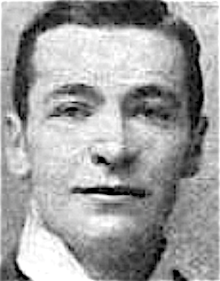
William George Robert Sprague [also known as W.G.R. Sprague] was born in Ballarat East, Victoria, Australia or New Zealand [1] on 6 September 1863. By 1874 he had moved to England and was articled to Frank Matcham (1854-1920) in London from 1879 to 1883 and to Walter Emden (1847-1913) from 1883 to 1886.
He commenced independent practice as an architect in London 1889 and sometimes collaborated with the architects William Robert 'Bertie' Crewe (1860-1937) and William Henry Barton (1871-1941). During a career of over thirty years he specialised in theatre architecture.
His address was given as 275 Cold Harbour Lane, Brixton, Surrey [now London] in 1891; 13 Arundel Street, Strand, London in 1898; 'Bungalow', Chestnut Avenue, Hampton, Middlesex in 1901; 'Chez Nous', Marine Parade, Tankerton, Whitstable, Kent in 1911 and 1913; and in 1928 at 'Chepstow', Lockmead, Cookham, Maidenhead, Berkshire, where he died on 4 December 1933
_____
[1] There is some uncertainty over Sprague's place of birth. According to ArthurLloyd.co.uk, recent research by John Earl, the former Director of the Theatres Trust, shows that he was born in Ballarat, Australia, in 1863, however, his place of birth is given as New Zealand in the 1891, 1901 and 1911 England Census and New Zealand birth registers seem to support this.
Theatres designed by Sprague included Theatre Royal, Lincolnshire, with Bertie Crew (1889); Olympic Theatre, junction of Drury Lane, Wych Street and Newcastle Street, London, with Bertie Crewe (1890); Theatre Royal, corner of Gordon Road and Birchett Road in Aldershot, Hampshire, with Bertie Crewe (1891); Camberwell Empire, Camberwell, London, with Bertie Crewe (1894); Lyceum Theatre, Bridge Street, , Newport, South Wales (1896); Shakespeare Theatre and Opera House, Lavender Hill, Battersea, London (1896); The Broadway, New Cross, London (1897); Grand Theatre, Fulham, London (1897); Lyceum Theatre, Sheffield (1897); The Coronet Theatre, Notting Hill Gate, London (1898); Kennington Theatre, London (1898); Wyndham's Theatre, Charing Cross Road, London (1899); The Rotherhithe Hippodrome, London (1899); Empire Theatre, Holloway, London (1899); The Hippodrome, Balham, London (1899-1900); Camden Theatre, Camden Town High Street, London (1901); King's Theatre, corner of Hammersmith Road and Rowan Road, London (1902); The New Theatre [later Albery Theatre], St. Martin's Lane, London (1902-03); The Strand Theatre, Strand, London (1905); The Aldwych Theatre, Aldwych, London (1905); Waldorf Theatre, Westminster, London (1905); The Hicks Theatre [renamed Gielgud Theatre in 1994], Shaftesbury Avenue, London (1906); The Queen's Theatre, Shaftesbury Avenue, London (1907); Théatrè Edward VII, Paris, France (c.1910); The Ambassadors Theatre, West Street, London (1913); Empire Theatre, Penge, London (c.1914); St Martin's Theatre, West Street, London (1913); and Streatham Hill Theatre, Lambeth, London, with William Henry Barton (1928-29).
Barson, Susie ‘The Camden Theatre’ Architect (1900): W. G. R. Sprague] Camden History Review no. 14, 1986, pp. 2-5
Costen, John. ‘The Edwardian theatres of W G R Sprague’. Issue no. 4, March 1984 pp. 66-71.
Directory of British Architects 1834-1914. Compiled by Antonia Brodie, et al. Volume 2: L-Z. London; New York: British Architectural Library, Royal Institute of British Architects/Continuum, 2001
Gray, A. Stuart. Edwardian architecture: a biographical dictionary. London: Gerald Duckworth & Co., Ltd., 1985
Monahan, Patrick. ‘The theatrebuilder’. Country Life vol. 207, no. 34, 21 August 2013 pp. 42-43.
'Obituary’. The Builder vol. 45, 22 December 1933, p. 985